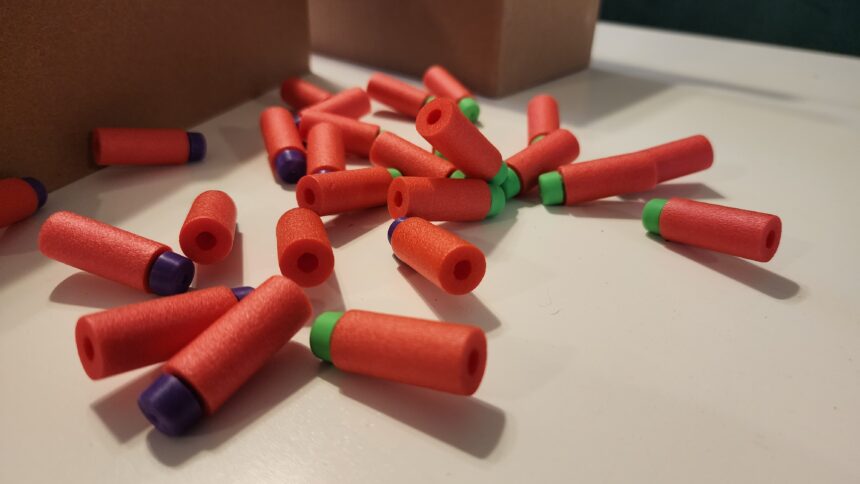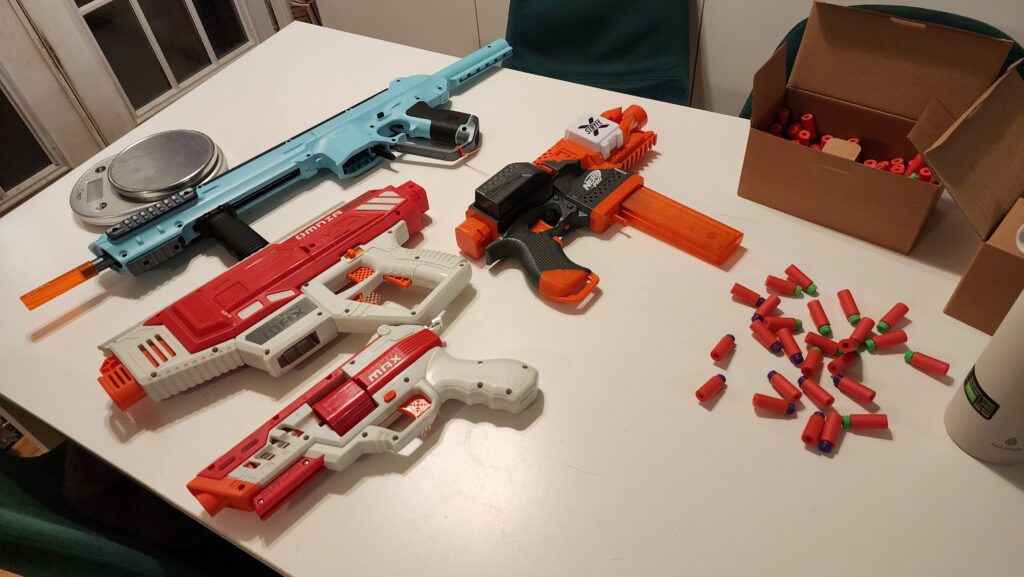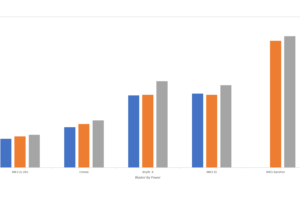
Worker Lightweight and Heavyweight Dart Review and Testing!
September 25, 2023First, a big thank you to Out of Darts! These showed up as a sample at my door, and I finally got time to test them this week. Within reason, I’ll also be trying them out at games.
Worker has new short darts available that sit outside the typical ~1g mass we expect to see. In theory, you could use these to boost or lower your FPS, in addition to tuning your blaster. More importantly, though, you could use the heavier darts to enhance your accuracy. We’ll discuss both possibilities!
Sort Them By The Head
 Two different kinds of dart were shipped to me: Heavyweight darts (denoted by green heads) and lightweight darts (purple heads). In my case, the foam for both is red. Different colored foams *might* perform slightly differently, but unless you’re Bradley Phillips, it really doesn’t matter outside of what color dart you can better track by eye or by camera.
Two different kinds of dart were shipped to me: Heavyweight darts (denoted by green heads) and lightweight darts (purple heads). In my case, the foam for both is red. Different colored foams *might* perform slightly differently, but unless you’re Bradley Phillips, it really doesn’t matter outside of what color dart you can better track by eye or by camera.
On paper, the darts are supposed to be 1.2g and .9g, respectively. Weighing them out at home, my samples actually averaged 1.19g and .85g! This compares to my store-bought Dart Zone Max darts, which averaged 0.95g and will be used for comparison.
 Testing consisted of, naturally, firing darts through multiple blasters of various power levels. I recorded the velocities from the chronograph, got the averages, and calculated the average kinetic energy while I was at it. Accuracy testing was admittedly less casual (again, others have done it better already), but I started off first by aiming at a post ~55ft away, then by going to the edge of my property to hit a small window on my house, ~75ft away. For that, I used my Dart Zone Max Outlaw, a Nerf Pro Stryfe X, and a Worker Harrier I used at Q4 of the 2022 Dart Zone Pro Tournament. For the sake of comparison, I fired it both with and without the SCAR attachment, since that was bound to make a difference by itself, considering the dart weights.
Testing consisted of, naturally, firing darts through multiple blasters of various power levels. I recorded the velocities from the chronograph, got the averages, and calculated the average kinetic energy while I was at it. Accuracy testing was admittedly less casual (again, others have done it better already), but I started off first by aiming at a post ~55ft away, then by going to the edge of my property to hit a small window on my house, ~75ft away. For that, I used my Dart Zone Max Outlaw, a Nerf Pro Stryfe X, and a Worker Harrier I used at Q4 of the 2022 Dart Zone Pro Tournament. For the sake of comparison, I fired it both with and without the SCAR attachment, since that was bound to make a difference by itself, considering the dart weights.
Dart Accuracy
Let’s get the easy (and more anecdotal) part out of the way. In general, the heavier the dart, the straighter it flew. Granted, at lower velocities, the difference was far less noticeable. Out of a stock Outlaw, for example, I was only hitting the pole at a slightly lesser rate with the lightweight darts, compared to the other two (the window was basically equivalent). In that case, the difference was small enough that user error in aiming *could* explain it just as well. Once the blaster power stepped up, however, the difference was clearer. Especially with the Worker Harrier – firing darts near 250fps accentuates the instabilities, and the heavier darts performed far better. Adding a SCAR attachment tightened the groupings, narrowing the wide shots and spirals to near misses, but the accuracy difference was still apparent.
Dart Velocity and Energy
Here’s where things get interesting! First, the springer results. This part was (relatively) lightly tested, but the results were consistent: springers gave you the same amount of energy regardless of dart mass. The plunger fires, pushing out the dart, and it’s a fast enough motion that, unless other factors interfere, you’re converting potential energy to kinetic energy in one fluid action. KE = 1/2MV^2, so if the mass decreases, the velocity will rise as a result, and so on. My high school physics teacher would be proud.
You could, of course, try to use differently massed darts to tune your velocity (most clubs have fps caps). But that could potentially run into issues down the line. After all, as a general rule, lots of clubs assume ~1g weight for darts (averaging out both short and long darts), so in those cases, the fps cap is also, for all intents and purposes, a kinetic energy cap. If people are using ~1.2g darts in order to drop below the cap, they’re also firing darts with 20% more kinetic energy. That’s not insignificant.
The issue gets more complicated with flywheel blasters! Those are dynamic systems, imparting energy to the dart the entire time it’s being squeezed between the wheels. Here, dart head shape, cage crush, foam density, motor torque, and lots of other things come into play. Heavier darts might not be traveling as fast as lighter ones after the first 0.1s within the flywheel cage, but that also means they’ll be in the cage longer, absorbing more energy! And that seems to be the case in general with flywheel blasters. There is a slight drop in overall FPS, but with the added weight, heavyweight darts have MUCH more kinetic energy when fired out of the same system. At least for springers, the darts had roughly equivalent kinetic energy.
Last Thoughts
I can see some cases where players may want to experiment with dart weights – after all, the heavier darts are going to be more stable in flight, with or without barrel attachments. In addition, at lower speeds the weight may not even matter! At a recent HvZ game, I loaded up my Outlaw with lightweight darts (averaging 127fps), and was able to hit people just fine, both at a distance and up close. At those speeds, you could theoretically find merit in giving a platform an fps boost, at least if you’re trying to land darts on target faster in close quarters.
Trying to use darts to make the fps cap, though? That’s going to be asking for trouble.
Even so, if you have a springer already tuned for the club fps cap, and you want heavier darts to tighten your dart groupings, the heavyweight darts might be worth a purchase!



